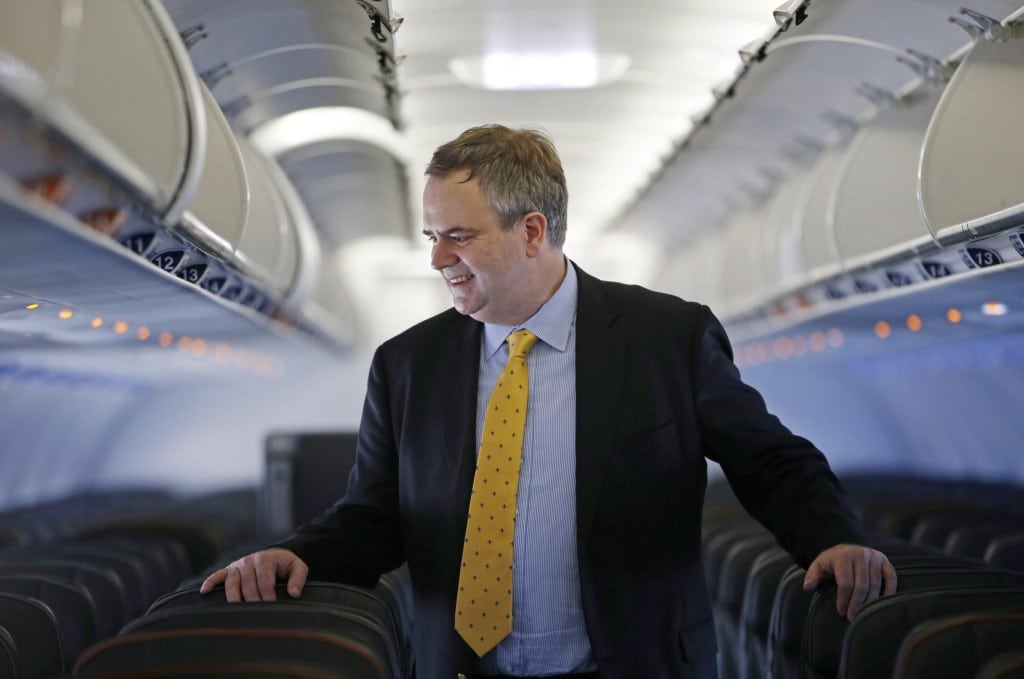Skift Take
JetBlue is taking its time in deciding whether to fly to Europe. We're guessing the airline is leaning that way, but it's hard to know for sure.
JetBlue Airways is doing a “major review” of its fleet, asking whether 100-seat Embraer 190s still fit in the airline’s network and if the carrier should acquire a long-range Airbus aircraft capable of flying to Europe, its CEO said Tuesday.
Speaking at the J.P. Morgan Aviation, Transportation & Industrials Conference in New York, JetBlue CEO Robin Hayes said the airline must decide by year-end whether to take the Airbus A321LR, assuming it wants the aircraft by 2019. The plane should be capable of flying from Boston and New York to the United Kingdom and perhaps other destinations in Western Europe.
“What will govern whether or not we do that is pretty simple,” Hayes said. “Will flying that airplane to … Europe drive a higher rate of return than flying it elsewhere in our network?”
Hayes reiterated that JetBlue sees opportunity to undercut competitors on price and still make money. He noted that the approach worked recently with JetBlue’s Mint business class cabin, which debuted in 2014 on New York-Los Angeles and New York-San Francisco routes. Since then, JetBlue has expanded Mint into other markets, and in many cases, it sells premium fares for less money than legacy carriers.
“There are a lot of characteristics [on] trans-Atlantic [routes] that we saw on the ‘Transcon’ in terms of very high premium fares” Hayes said.
Hayes added that the propsect of trying to “skim” market share from other carriers is intriguing. “But it’s not just whether it’s compelling,” he said. “It’s whether that is going to be the highest rate of return of that airplane versus other uses of it.”
E190s under review
The E190s, JetBlue’s smallest aircraft, are another matter. JetBlue is among the world’s largest operators of the Brazilian-made jet, but it has fallen out of favor in recent years, because it is far more expensive to operate, on a per seat basis, than larger aircraft. JetBlue took its first E190 in 2005.
“It is a higher CASM airplane,” Hayes said, using an acronym for cost-per-available seat mile, a term the industry uses to gauge the cost of flying an aircraft on a per seat basis. Generally, larger and newer aircraft have lower costs per seat.
He said JetBlue’s new CFO, Steve Priest, is examining the current fleet and upcoming orders to make sure the carrier will have the right aircraft mix. “We have shown a lot of flexibility over the years,” Hayes said, promising the carrier will make tweaks, if required.
Other airlines have given up on the E190 in recent years. Last year, American Airlines said it would retire all of its E190s by 2019, even though it did not start flying them until 2007. Also, Air Canada is slowly reducing its E190 fleet as it adds new aircraft.
“We believe JetBlue’s 60 E-190s are a disproportionate cost drag on JetBlue’s cost structure and, while valuable in certain markets like Boston, create operational and product complexity and give JetBlue more reasons to open up markets where the airline’s presence probably isn’t needed,” Hunter Keay, an analyst at Wolfe Research, wrote in a recent report.
In some markets, however, E190s serve a purpose. Though the E190s are considerably more expensive for JetBlue on a per seat basis than a 162-seat Airbus A320, the cost for operating each flight is still cheaper with a smaller aircraft. In some markets where JetBlue calculates it can only sell 100 seats, it could be more cost effective to fly E190s than half-full A320s.
“We look at the 190 not as a CASM issue but as a returns issue,” Hayes said. “What is the fleet that will optimize the highest rate of returns from our network?”
The Daily Newsletter
Our daily coverage of the global travel industry. Written by editors and analysts from across Skift’s brands.
Have a confidential tip for Skift? Get in touch
Tags: jetblue airways
Photo credit: Robin Hayes walks through the aisle of a JetBlue plane at JFK airport in New York. JetBlue is evaluating its fleet mix as it considers whether to fly to Europe. Kathy Willens / Associated Press
